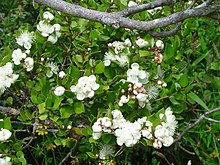Luma apiculata
| Luma apiculata | ||||||||||||
|---|---|---|---|---|---|---|---|---|---|---|---|---|

Forest with Luma apiculata |
||||||||||||
| Systematics | ||||||||||||
|
||||||||||||
| Scientific name | ||||||||||||
| Luma apiculata | ||||||||||||
| ( DC. ) Burret |
The Luma apiculata is a species of the myrtle family (Myrtaceae). It is native to Chile and Argentina and is called "Arrayán" there like many other species of the Myrtaceae family.
description
Appearance and leaf
Luma apiculata grows as an evergreen tree (up to a shrub ) that reaches heights of growth of up to 25 meters and trunk diameters of up to 60 centimeters. The upper orange-colored (cinnamon-colored) bark peels off easily and the whitish, smooth bark becomes visible. The bark of the branches is hairy reddish and downy.
The fragrant, oppositely arranged leaves are divided into a petiole and a leaf blade. The petiole is relatively short with a length of 1 to 2 mm. The simple leaf blade is 1 to 2.5 centimeters long and 0.5 to 2 centimeters wide and elliptical with a finely pointed upper end (hence the epithet apiculata ). The middle nerve and the leaf margin are usually downy hairy.
Flower, fruit and seeds
The flowering period in South America extends from January to February. In the leaf axils there are three to five flowers on a 7 to 12 mm long inflorescence stem. The hermaphrodite flowers are radial symmetry and four-fold with a double flower envelope . The four sepals are fused. The four free petals are white and 6 to 9 mm long. The 170 to 300 stamens are 5 to 7 mm long. The 6 to 7 mm long stylus ends in a simple scar.
The edible, fleshy and shiny berry is almost spherical with a diameter of up to 1 cm, turns black-purple when ripe and contains 1 to 16 seeds. The seed is 3 to 6 mm long.
Occurrence
Luma apiculata is native to southern South America in Chile and Argentina. It occurs in Chile in regions V to XI from Valparaíso to Aisén at altitudes of up to 700 meters. In Argentina, the distribution area is in the regions of Chubut , Neuquén and Río Negro .
The locations are mostly damp, but never with waterlogging. Most often comes Luma apiculata in Evergreen forests, or associated with Hualo -Südbuche ( Nothofagus glauca ), Rauli -Südbuche ( Nothofagus alpina ) and nothofagus dombeyi ( Nothofagus dombeyi ) fitzroya = alerce ( Fitzroya cupressoides ) and Chile cedar ( Austrocedrus chilensis ) in front.
Taxonomy
The first description was made in 1828 under the name ( Basionym ) Eugenia apiculata by the Swiss botanist Augustin-Pyrame de Candolle in Prodromus Systematis Naturalis Regni Vegetabilis , Volume 3, p. 276. The German botanist Carl Burret posted in 1941 in the memo sheet of the Botanical Garden and Museum Berlin-Dahlem , Volume 15 (3), p. 523 this species under the name Luma apiculata into the genus Luma . The specific epithet apiculata refers to the shape of the leaves. Other synonyms for Luma apiculata ( DC. ) Burret are Eugenia luma O.Berg and Myrceugenia apiculata ( DC. ) Nied. .
use
The fruits are edible.
The Arrayán was used by the Mapuche for medicinal purposes.
The very hard and resistant wood is processed into tool handles, for example, or makes good firewood.
Luma apiculata is used as an ornamental plant in parks and gardens and can be cut into hedges or shaped as bonsai .
swell
Individual evidence
- ↑ a b c Gordon Cheers (Ed.): Botanica. The ABC of plants. 10,000 species in text and images . Könemann Verlagsgesellschaft, 2003, ISBN 3-8331-1600-5 , p. 543 .
- ↑ a b c d e f g h i data sheet at Enciclopedia de la Flora Chilena . (Spanish) last accessed on February 22, 2013
- ↑ First description scanned at biodiversitylibrary.org .
- ^ Luma apiculata in the Germplasm Resources Information Network (GRIN), USDA , ARS , National Genetic Resources Program. National Germplasm Resources Laboratory, Beltsville, Maryland. Retrieved April 17, 2013.
- ^ Luma apiculata , synonyms at Tropicos.org. Missouri Botanical Garden, St. Louis, accessed April 17, 2013.
Web links
- Luma apiculata at Useful Temperate Plants.


